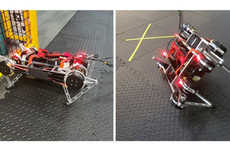
Google's PaLM-SayCan Model Mimics Human Reasoning Capabilities
Colin Smith — August 25, 2023 — Tech
References: aibusiness
PaLM-SayCan is a robotics algorithm that combines the understanding of language models with the real-world capabilities of a helper robot. It is a collaboration between Google Research and Everyday Robots, a company that builds robots that can learn by themselves. PaLM-SayCan uses Google Research’s state-of-the-art language model, PaLM, which can solve complex math word problems, answer questions in new languages, and explain jokes. PaLM-SayCan enables a helper robot to perform a series of complex tasks using chain of thought prompting, which interprets natural language instructions and splits them into sub-tasks for the robot to execute.
PaLM-SayCan is a breakthrough in AI and robotics research, as it shows the possibility of robots that can understand us and help us with (almost) anything. Unlike typical robotic demos that perform a single task in a constrained environment, PaLM-SayCan shows that a robot can carry out multiple requests in a real-world environment using reasoning. This also makes it easier for people to interact with robots, as they can use everyday language instead of code or commands. PaLM-SayCan demonstrates the potential for more helpful, human-centered robots in the future.
Image Credit: Google Research, Everyday Robots
PaLM-SayCan is a breakthrough in AI and robotics research, as it shows the possibility of robots that can understand us and help us with (almost) anything. Unlike typical robotic demos that perform a single task in a constrained environment, PaLM-SayCan shows that a robot can carry out multiple requests in a real-world environment using reasoning. This also makes it easier for people to interact with robots, as they can use everyday language instead of code or commands. PaLM-SayCan demonstrates the potential for more helpful, human-centered robots in the future.
Image Credit: Google Research, Everyday Robots
Trend Themes
1. Advanced Language Models - PaLM-SayCan utilizes Google Research's state-of-the-art language model, PaLM, to solve complex problems and understand natural language instructions, opening up possibilities for more advanced language models in AI and robotics.
2. Chain of Thought Prompting - PaLM-SayCan uses chain of thought prompting to interpret natural language instructions and break them down into manageable sub-tasks, highlighting the potential for more efficient task execution and improved human-robot interaction.
3. Real-world Robotic Applications - PaLM-SayCan showcases the ability of robots to carry out multiple requests in a real-world environment, paving the way for practical and versatile robotic applications in various industries.
Industry Implications
1. Artificial Intelligence - The integration of advanced language models like PaLM-SayCan can transform AI by enabling machines to understand natural language and solve complex problems with greater efficiency and accuracy.
2. Robotics - The breakthrough of PaLM-SayCan demonstrates the potential for more capable and human-centered robots, opening up opportunities for advancements in robotics and the development of robots that can perform complex tasks in real-world environments.
3. Human-robot Interaction - PaLM-SayCan's language understanding capabilities simplify human-robot interaction, making it more accessible and intuitive for individuals to communicate with robots using everyday language, providing opportunities for improved user experiences and collaborations.
4.9
Score
Popularity
Activity
Freshness















